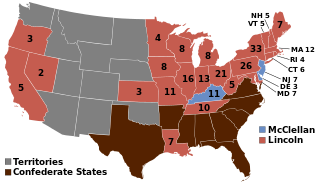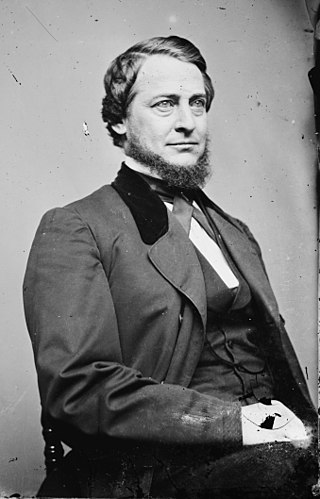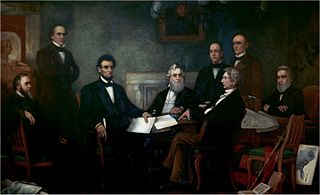
Abraham Lincoln was an American lawyer, politician, and statesman who served as the 16th president of the United States from 1861 until his assassination in 1865. Lincoln led the United States through the American Civil War, defending the nation as a constitutional union, defeating the insurgent Confederacy, playing a major role in the abolition of slavery, expanding the power of the federal government, and modernizing the U.S. economy.

The American Civil War was a civil war in the United States between the Union and the Confederacy. The Confederacy had been formed by states that had seceded from the Union. The central conflict leading to the war was the dispute over whether slavery would be permitted to expand into the western territories, leading to more slave states, or be prevented from doing so, which many believed would place slavery on a course of ultimate extinction.

The Emancipation Proclamation, officially Proclamation 95, was a presidential proclamation and executive order issued by United States President Abraham Lincoln on January 1, 1863, during the American Civil War. The Proclamation had the effect of changing the legal status of more than 3.5 million enslaved African Americans in the secessionist Confederate states from enslaved to free. As soon as slaves escaped the control of their enslavers, either by fleeing to Union lines or through the advance of federal troops, they were permanently free. In addition, the Proclamation allowed for former slaves to "be received into the armed service of the United States". The Emancipation Proclamation played a significant part in the end of slavery in the United States.

The 1864 United States presidential election was the 20th quadrennial presidential election. It was held on Tuesday, November 8, 1864. Near the end of the American Civil War, incumbent President Abraham Lincoln of the National Union Party easily defeated the Democratic nominee, former General George B. McClellan, by a wide margin of 212–21 in the electoral college, with 55% of the popular vote. For the election, the Republican Party and some Democrats created the National Union Party, especially to attract War Democrats.

George Brinton McClellan was an American military officer and politician who served as the 24th governor of New Jersey and as Commanding General of the United States Army from November 1861 to March 1862. He was also an engineer, and was chief engineer and vice president of the Illinois Central Railroad, and later president of the Ohio and Mississippi Railroad in 1860.

Salmon Portland Chase was an American politician and jurist who served as the sixth chief justice of the United States from 1864 to his death in 1873. Chase served as the 23rd governor of Ohio from 1856 to 1860, represented Ohio in the United States Senate from 1849 to 1855 and again in 1861, and served as the 25th United States Secretary of the Treasury from 1861 to 1864 during the administration of Abraham Lincoln. Chase is therefore one of the few American politicians who have served in all three branches of the federal government, in addition to serving in the highest state-level office. Prior to his Supreme Court appointment, Chase was widely seen as a potential president.

Clement Laird Vallandigham was an American lawyer and politician who served as the leader of the Copperhead faction of anti-war Democrats during the American Civil War.

Edwin McMasters Stanton was an American lawyer and politician who served as U.S. Secretary of War under the Lincoln Administration during most of the American Civil War. Stanton's management helped organize the massive military resources of the North and guide the Union to victory. However, he was criticized by many Union generals, who perceived him as overcautious and micromanagerial. He also organized the manhunt for Abraham Lincoln's assassin, John Wilkes Booth.

Lincoln: A Novel is a 1984 historical novel, part of the Narratives of Empire series by Gore Vidal. The novel describes the presidency of Abraham Lincoln and extends from the start of the American Civil War until his assassination. Rather than focus on the Civil War itself, the novel is centred on Lincoln's political and personal struggles. Though Lincoln is the focus, the book is never narrated from his point of view ; Vidal instead writes from the perspective of key historical figures. He draws from contemporary diaries, memoirs, letters, newspaper accounts, the biographical writings of John Hay and John Nicolay, and the work of modern historians.

The Battle of Fort Pillow, also known as the Fort Pillow massacre was fought on April 12, 1864, at Fort Pillow on the Mississippi River in Henning, Tennessee, during the American Civil War. The battle ended with Confederate soldiers commanded by Major General Nathan Bedford Forrest massacring U.S. Army soldiers attempting to surrender. Military historian David J. Eicher concluded: "Fort Pillow marked one of the bleakest, saddest events of American military history."

Katherine Jane Chase Sprague was a Washington society hostess during the American Civil War. During the war, she married Rhode Island Governor William Sprague.

During the American Civil War, the State of Ohio played a key role in providing troops, military officers, and supplies to the Union army. Due to its central location in the Northern United States and burgeoning population, Ohio was both politically and logistically important to the war effort. Despite the state's boasting a number of very powerful Republican politicians, it was divided politically. Portions of Southern Ohio followed the Peace Democrats and openly opposed President Abraham Lincoln's policies. Ohio played an important part in the Underground Railroad prior to the war, and remained a haven for escaped and runaway slaves during the war years.

During the American Civil War (1861–1865), Maryland, a slave state, was one of the border states, straddling the South and North. Despite some popular support for the cause of the Confederate States of America, Maryland did not secede during the Civil War. Governor Thomas H. Hicks, despite his early sympathies for the South, helped prevent the state from seceding.

The presidency of Abraham Lincoln began on March 4, 1861, when Abraham Lincoln was inaugurated as the 16th president of the United States, and ended upon his assassination and death on April 15, 1865, 42 days into his second term. Lincoln was the first member of the recently established Republican Party elected to the presidency. Lincoln successfully presided over the Union victory in the American Civil War, which dominated his presidency and resulted in the end of slavery.

Tennessee Johnson is a 1942 American film about Andrew Johnson, the 17th president of the United States, released by Metro-Goldwyn-Mayer. It was directed by William Dieterle and written by Milton Gunzburg, Alvin Meyers, John Balderston, and Wells Root.

Anna Ella Carroll was an American political activist, pamphleteer and lobbyist. She wrote many pamphlets criticizing slavery. She played a significant role as an adviser to the Lincoln presidential cabinet during the American Civil War (1861–1865).
The Dix–Hill Cartel was the first official system for exchanging prisoners during the American Civil War. It was signed by Union Major General John A. Dix and Confederate Major General D. H. Hill at Haxall's Landing on the James River in Virginia on July 22, 1862.

Team of Rivals: The Political Genius of Abraham Lincoln is a 2005 book by Pulitzer Prize-winning American historian Doris Kearns Goodwin, published by Simon & Schuster. The book is a biographical portrait of U.S. President Abraham Lincoln and some of the men who served with him in his cabinet from 1861 to 1865. Three of his Cabinet members had previously run against Lincoln in the 1860 election: Attorney General Edward Bates, Secretary of the Treasury Salmon P. Chase and Secretary of State William H. Seward. The book focuses on Lincoln's mostly successful attempts to reconcile conflicting personalities and political factions on the path to abolition and victory in the American Civil War.

First Reading of the Emancipation Proclamation of President Lincoln is an 1864 oil-on-canvas painting by Francis Bicknell Carpenter. In the painting, Carpenter depicts Abraham Lincoln, the 16th president of the United States, and his Cabinet members reading over the Emancipation Proclamation, which proclaimed the freedom of slaves in the ten states in rebellion against the Union in the American Civil War on January 1, 1863. Lincoln presented the preliminary Emancipation Proclamation to his Cabinet on July 22, 1862 and issued it on September 22, 1862. The final Emancipation Proclamation took effect on January 1, 1863.

William Martin Dickson, also known as William M. Dickson (1827–1889), was a lawyer, prosecuting attorney, and judge from Cincinnati, Ohio, United States. He was one of the founders of the Republican Party and assisted in the framing of the Emancipation Proclamation. Alphonso Taft, the father of President and Chief Justice William Howard Taft, and Thomas Marshall Key were his law partners.

















